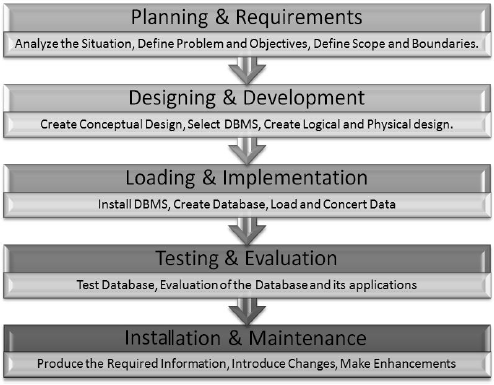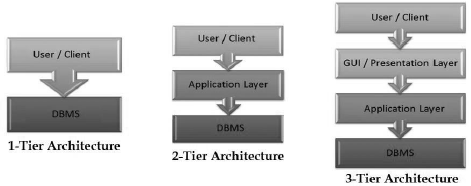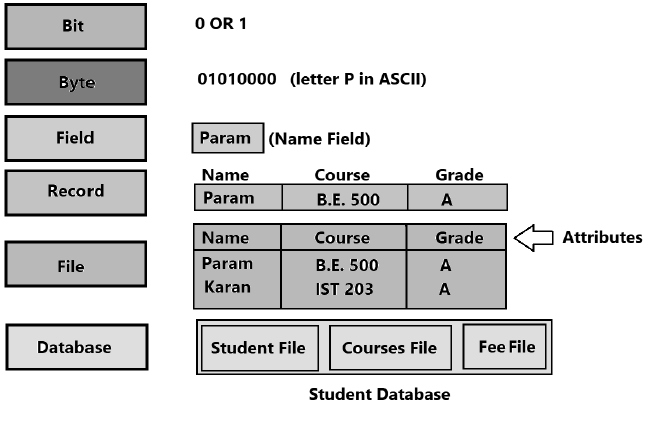Please refer to Database Management System Class 11 Computer Science Important Questions with solutions provided below. These questions and answers have been provided for Class 11 Computer science based on the latest syllabus and examination guidelines issued by CBSE, NCERT, and KVS. Students should learn these problem solutions as it will help them to gain more marks in examinations. We have provided Important Questions for Class 11 Computer Science for all chapters in your book. These Board exam questions have been designed by expert teachers of Standard 11.
Class 11 Computer Science Important Questions Database Management System
Very Short Answer Type Questions:
Question: DBMS stands for?
Ans: Database Management System
Question: Related information of a particular item may be treated as?
Ans: Record
Question: The Collection of Files or Tables is known as?
Ans: Database
Question: Who maintains the DBMS and are responsible for administrating the database?
Ans: Database Administrator (DBA)
Question: Who are the group of people who actually work on the designing part of the database?
Ans: Designer
Short Answer Type Questions:
Question: What is Cloud database?
Ans: A cloud database is a database that typically runs on a cloud computing platform. Internet is used to access cloud databases. Cloud Database Services can be accessed in two ways:
• In the first method, an organization purchases virtual machine space from a cloud service provider, and stores the database on the cloud. IT staff is used by the organization to control the database. In this system, the organization is responsible for monitoring and managing the database.
• In the second method, the organization makes a subscription-based agreement with the cloud service provider. The database is stored on the cloud server, but the cloud service provider allows the database to be used as a service (Database as a service-DBaaS).
Question: Define about DBMS Working?
Ans: DBMS stands for Database Management System. It is basically a computerized record keeping system. A DBMS stores data in a way that makes it easy to retrieve information, modify data, and create information. A DBMS has many different types of users and each user can have different rights to perform different types operations on the database. These different users use the database for different purposes. For example: some users retrieve data and some takes its backup.
Question: Define the 2-tier DBMS architecture in DBMS?
Ans: DBMS has different types of architectures: such as 1-tier architecture, 2-tier architecture, 3-tier architecture, etc. DBMS’s 2- tier architecture incorporates an application layer between users and DBMS. This layer is responsible for forwarding the user’s request to the Database Management System and then transmits the response
from the DBMS to the user.

Question: Explain the Application Areas of DBMS?
Ans: Some of the DBMS application areas are listed below:
• DBMS is used to store student records in educational institutions.
• DBMS is used to store bank customer information.
• DBMS is used to store call records, monthly bills etc. information in the telecommunications sector.
• DBMS is used to track the production and supply of goods in the manufacturing sector.
• DBMS is used to store reservations and schedule information in the Tours and travel industry.
Question: What do you mean by End User?
Ans: A DBMS has many different types of users and each user can have different rights to perform different types operations on the database. END USERS is a type of DBMS user. It includes those users who actually benefit from DBMS. End users can range from general audiences to intelligent users like business analysts.
Long Answer Type Questions:
Question: Explain about Data Base Life Cycle?
Ans: A Software/System Development Life Cycle (SDLC) model is a set of different functions that are defined to accomplish the task of developing a software application. There are several activities involved in developing any software / system:
• Planning: Analysing the problem to define it
• Requirements: Knowing the needs of the users
• Design: Creating a logical and physical design of the database.
• Development: Creating a database according to the design
• Implementation: Installing a database system in user’s computer systems
• Testing: Fill the data in the database to test it
• Installation and Maintenance: Modifying the database system to fix problems or improve the database.

Question: Explain the Limitations of Database Management System?
Ans: The major limitations of the Database Management System are as follows:
• Setup cost: DBMS requires huge investment in hardware and software.
• Database Complexity: Designing a database system is a complex, difficult and time consuming task.
• Technical staff required: Technical staff is required to use the database. Developers, designers, DBA and end users must have full expertise to handle the complexities of the database.
• Database failure: Database system failure can lead to loss of valuable data.
• Performance (work efficiency): The traditional file system was great for small organizations because they give excellent performance. But DBMS performs poorly for small firms because it works slowly.
Question: Explain the Features of Database Management System?
Ans: Key features of the database management system are described as follows:
• Reducing data redundancy: Redundancy of data means duplication of data. Multiple copies of the same file/data in a file-based system lead to data duplication. It can be prevented with DBMS.
• Sharing data: Different users of the database can share data among themselves.
• Data consistency: This means that the data in the database is accurate and consistent. Data consistency is compromised when there is duplication of data. DBMS eliminates data
duplication which keeps the data consistent.
• Data Security: Only authorized users can access the database. The identity of these users is verified using a username and password.
• Privacy: In a database system a user can only view/use the data that he/she is allowed to use.
• Backup and Recovery: The database system automatically backs up and recovers data from time to time.
Question: Explain about Architecture of DBMS?
Ans: The database management system is made up of many interrelated components. The architecture of DBMS specifies how to organize these components. The architecture of a DBMS can be based on Centralized (storing all data at one place), Decentralized (multiple copies of databases at different locations) or Hierarchical architecture. The purpose of architecture is to separate user applications and physical-databases. The following are some of the types of database architectures:
• 1-tier DBMS architecture: It is directly available to database users to store data.
• 2-tier DBMS architecture: This architecture incorporates an application layer between users and DBMS. This layer is responsible for forwarding the user’s request to the database
management system and then transmits the response from the DBMS to the user.
• 3-tier DBMS architecture: This architect is commonly used for web applications. The 3-tier architecture includes an additional presentation layer, which provides the end user with a
graphical user interface (GUI) for interacting with DBMS.

Question: Make the chart about hierarchy of Database?
Ans: The hierarchical chart of the database is shown below:



